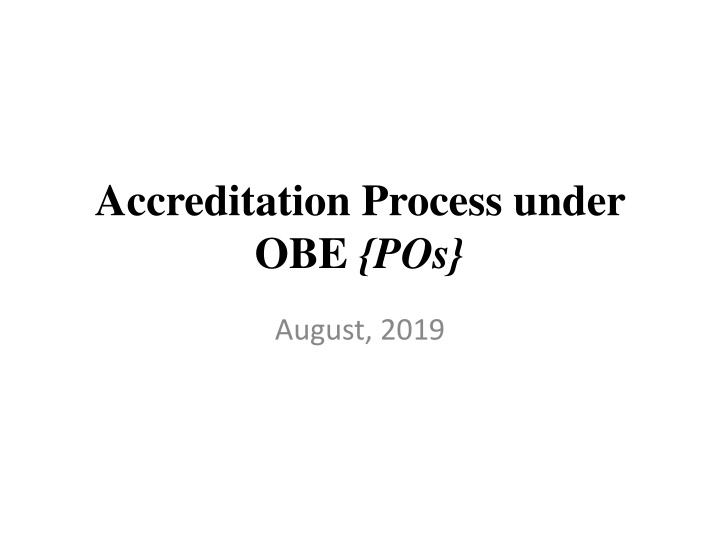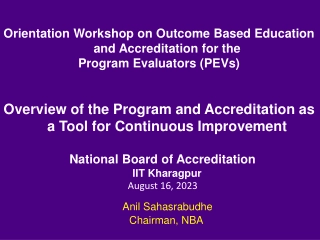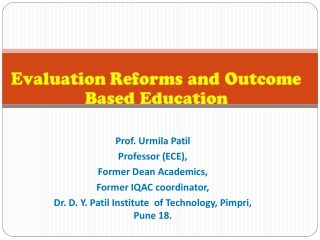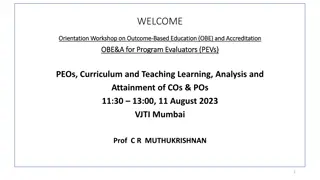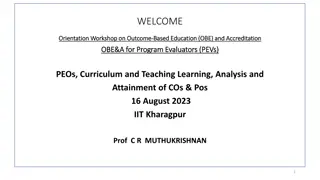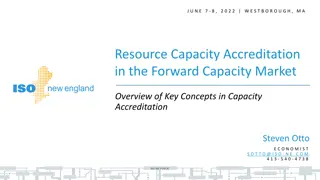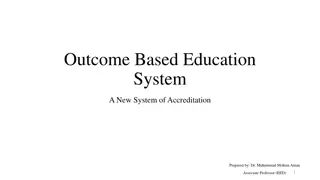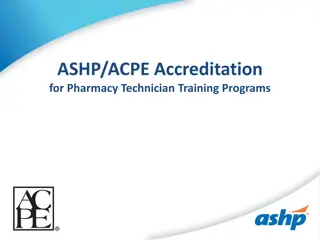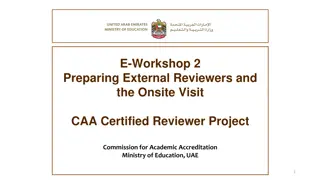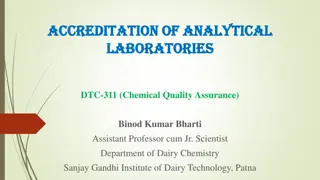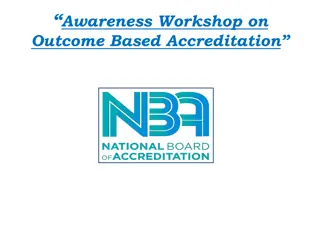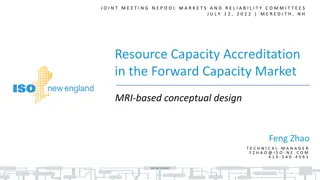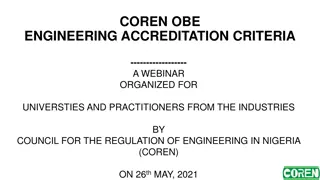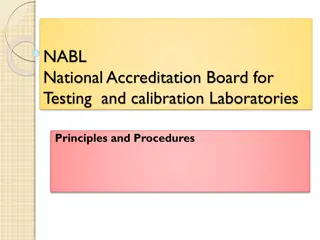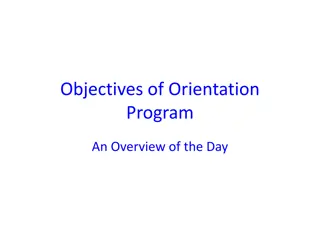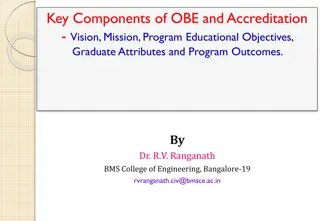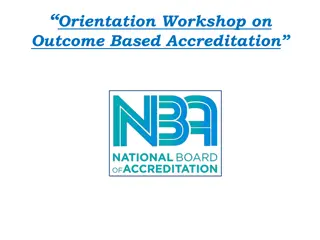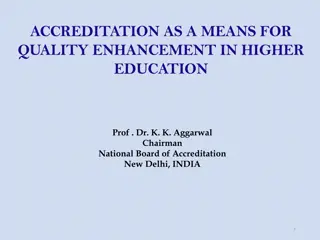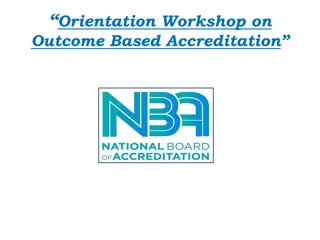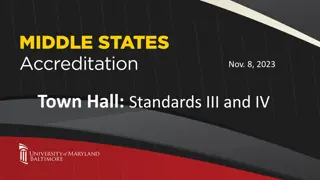Outcome-Based Education (OBE) in Accreditation Processes
Outcome-Based Education (OBE) is a crucial aspect in accreditation processes, focusing on defining learning outcomes and aligning curriculum, instruction, and assessment to ensure students achieve essential skills. OBE is not just for accreditation but also about enhancing the quality of education. This approach involves stakeholders like industry and academia in defining learning outcomes, ultimately leading to the development of a clear graduate profile in engineering.
Download Presentation

Please find below an Image/Link to download the presentation.
The content on the website is provided AS IS for your information and personal use only. It may not be sold, licensed, or shared on other websites without obtaining consent from the author.If you encounter any issues during the download, it is possible that the publisher has removed the file from their server.
You are allowed to download the files provided on this website for personal or commercial use, subject to the condition that they are used lawfully. All files are the property of their respective owners.
The content on the website is provided AS IS for your information and personal use only. It may not be sold, licensed, or shared on other websites without obtaining consent from the author.
E N D
Presentation Transcript
Accreditation Process under OBE {POs} August, 2019
Outcomes at the Heart of the Accreditation Process
Over time, Learning Outcomes have come to Play a Crucial Role in the Accreditation Processes {Almost} the World Over.
Of Course, OBE is not only for Accreditation It is about Quality of Education Curriculum OBE Curriculum & Teaching/Learning Assessment
Curriculum & Teaching/Learning Assessment Qu. What are the Roles of these two components?
Confusion Yes, it is needed, But what is it?
Outcome-Based Education: Critical Issues and Answers by William G Spady What does the term "Outcome-Based Education" really mean?
Outcome-Based Education means clearly focusing and organizing every-thing in an educational system around what is essential for all students to he able to do** successfully at the end of their learning experiences. This means starting with a clear picture of what is important for students to he able to do, then organizing curriculum, instruction, and assessment to make sure this learning ultimately happens.
In Engineering, OBE Leads to: Defining of the Graduate Profile Through Learning Outcomes Defining Good
A Couple of more Questions: Qu.1. Who Defines the Learning Outcomes? Ans. The Stakeholders of that Program. Then, Qu.2. Who are the Stakeholders? Ans. In Engineering- Industry and Academia
Key Terms Accreditation Criteria Program Educational Objectives PEO Course Outcomes CO Program Outcomes PO Assessment Evaluation
Accreditation is a Judgment on the Program- Acceptable/ Not Acceptable Has to be Objective & Consistent Criteria
How to make the judgment? Criteria-Rule book Evidence on Record As dictated by the Accreditation Criteria and Evidence on record
Role of the two criteria Program Curriculum PO Program Outcomes Curriculum and the Teaching/ Learning processes are the basis on which the program is built Attainment of POs indicates that the job is well done
One Question (?) In an Institution all the inputs - Infrastructure, students, faculty, curriculum- are Good. Q. Will the graduates be NOT GOOD*? ? Ans. May be- May be Not: We just don t know! In OBE, we determine
Clearly, Outcomes have to be (and Are) Measurable make sure
Evidence "Not a particle of evidence, Pip," said Mr. Jaggers, shaking his head. "Take nothing on its looks; take everything on evidence. There's no better rule."
For Evaluators So, while writing their report: The Evaluators could always state as: Based on the following evidence presented and evaluated by us the following conclusions can bearrived at { }
SAR-Evaluations Major Factors Vision and Mission & PEO Curriculum & Teaching- Learning {Program Outcomes (PO) Course Outcomes (CO)} Consistency and Interactions Amongst These- Matrices
We Examine PEO- very briefly for the sake of completeness. It answers the question: Why has the program been created in the first place
Short Definitions of CO, PO Program Outcomes- POs These are knowledge and skill sets that the graduates have at the time of graduations** Course Outcomes- COs Again, these are knowledge and skills that are attained by the graduates in a course {Could be a part of a PO} COs are mapped onto POs { CO-PO matrix}
Qu. Why are the NBAs POs , What they are?
WA Graduate Attributes and NBA- Program Outcomes Washington Accord Attributes 1.Engineering knowledge,Apply knowledge of mathematics, science, engineering fundamentals and an engineering specialization to the solution of complex engineering problems. 2. Problem Analysis,Identify, formulate, research literature and analyze complex engineering problems reaching substantiated conclusions using first principles of mathematics, natural sciences and engineering sciences NBA Program Outcomes. 1.Engineering knowledge, Apply the knowledge of mathematics, science, engineering fundamentals, and engg. specialization to the solution of complex engineering problems 2. Problem Analysis, Identify, formulate, research literature, and analyze engineering problems to arrive at substantiated conclusions using first principles of mathematics, natural, and engineering sciences.
Clearly, Outcomes have to be Measurable
NBA-Learning Outcomes 1. Engineering Knowledge, 2. Problem Analysis 3. Design/development of solutions, 4. Conduct investigations of complexProblems, 5. Modern tool usage, 6. The engineer and society, 7. Environment and sustainability, 8. Ethics, 9. Individual and team work, 10. Communication, 11. Project management and finance, 12. Life-long learning
Program Outcomes - POs Have to be Understood Some are difficult to Attain Also, difficult to Assess and Evaluate {Today s discussion is about this Aspect} We examine all these aspects.
1. Engineering knowledge: Apply the knowledge of mathematics, science, engineering fundamentals, and engg. specialization to the solution of complex engineering problems. 2. Problem analysis: Identify, formulate, research literature, and analyze engineering problems to arrive at substantiated conclusions using first principles of mathematics, natural, and engineering sciences. 3. Design/development of solutions: Design solutions for complex engineering problems and design system components, processes to meet the specifications with consideration for the public health and safety, and the cultural, societal, and environmental considerations. 4. Conduct investigations of complex problems: Use research-based knowledge including design of experiments, analysis and interpretation of data, and synthesis of the information to provide valid conclusions.
For Evaluators Assessment It is one or more processes that identify, collect, and prepare data to evaluate the achievement of Program Outcomes and program educational objectives Important for both, SAR and the Evaluators
For Evaluators Evaluation These are processes for interpreting the data and evidence accumulated through assessment practices. Evaluation determines the extent to which POs or PEOs are being achieved, and results in decisions and actions to improve the program as also for accreditation.
Why place these four POs in one Basket? The Statements show that one part {That of (complex) Engineering Problem CEP} is common to all. Though, individually each PO deals with a different aspect of CEP. Recognizing this commonality makes the discussion easier.
The different aspects of CEP Application of Mathematics and sciences- PO1 Identify and Research to Solve PO 2 Design and Development of Solutions PO 3 Conducting Investigations and Research PO 4
We need to be able to Determine if the course does have such problems in its Assessment
Sample Indicators of Complex Engineering Problems-CEP {Some Hints for the Evaluators} 1. Problems not the kind generally encountered at the ends of text book chapters. (These often test if the contents of the chapter have been understood) 2. These are problems that have not been completely framed and leave at least a few* choices for the student to make. 3.Problems may require use of laws of physics, or bring in some mathematical tools in which the problem can be framed.
Choices Not Easy {Hints Continued} Qu. What are the available Choices? {Open Ended} Requires: Experience, Engineering Knowledge, Understanding, Ability to define and manage constraints that are Applicable, and manage these. These make it a Complex Engineering Problem
Tier -1 and Tier-2 For tier 1 , (2) could read as- only skeletal details provided in the problem, and student is required make out the rest. Such a problem could require amongst others defining constraints in terms of power, cost, weight, life span, different engineering choices, etc. For such problems, there are, in all probability multiple valid solutions. Difference between Tier-2 and Tier 1, in this respect, is in the degree of complexity and numbers
Another Take on CEP {from CEAB, Canada}
According to the CEAB, a complex engineering problem is defined by the following characteristics: 1. It must require the application of in-depth knowledge 2. It must satisfy at least one of the following additional characteristics: involves wide-ranging or conflicting issues has no obvious solution such that originality is required involves infrequently encountered issues is outside accepted standards and codes involves diverse stakeholders and needs is posed at a high-level with many components or sub- problems
Factors We Examine Assessment: { Information and Evidence for Evaluation of attainment} Evaluation: {From the evidence making judgments on attainment levels} We examine both the factors from procedural and, evidence interpretation aspects
The First Step Towards Assessment: {We recognize that POs are attained through the COs. So we determine the corresponding set COs. These COs in turn lead us to courses - the places where we find information and evidences} This step is pictured in the next slide. We will need the CO-PO matrix for this. It is there in the SAR
The Sequence From Which CO? From Which Course? A Given PO Look for Evidence In that Course!
Mapping from the CO-PO matrix {from SAR} PO 1 Set of {COs} & {Associated set of Courses} PO 2 PO 3 PO 4
Every Course Leads to Some Outcomes. All the courses must cover the stated list of outcomes. One way of verifying this to prepare a match matrix as shown below. In the table below * could also be a number- typically in (0,1) indicating level of attainment. Course PO PO 1 EE 111 EE 212 HS 101 PO 2 PO 9 * * * * * *
Every Course Leads to Some Outcomes. All the courses together must cover all the POs (and PSOs). For a course we map the COs to POs through the CO-PO matrix shown below. Assume that it is for a course EE111 CO PO PO 1 * PO 2 PO 9 CO 1 CO 2 CO n * * * *
Determining Attainment of POs To Begin with, an Evaluator Asks: Qu. How Good are the COs?
Are the COs well defined? CO Analysis- How well do the CO statements match with the PO statements? Very often a part of a PO is embedded in the CO. Else, we reason on the degree of match. CO Statement Compare PO statement Continued
Answer to this question could be in terms of degree of match such as: (a) Excellent/ 4 (b) Good / 3 (c) Fair /2 (d) Little /1 {To be recorded for all the COs. Examples follow}
